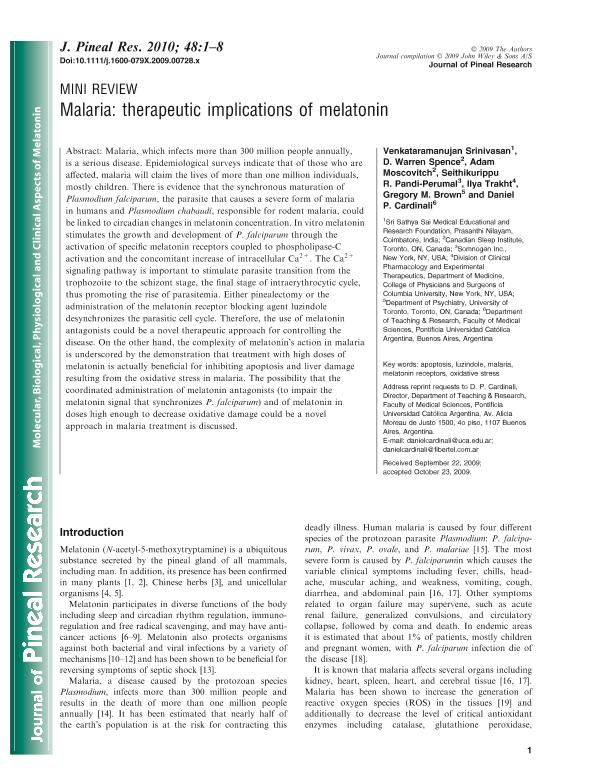Mostrar el registro sencillo del ítem
dc.contributor.author
Srinivasan, Venkataramanujan
dc.contributor.author
Spence, David Warren

dc.contributor.author
Moscovitch, Adam
dc.contributor.author
Pandi Perumal, Seithikurippu R.

dc.contributor.author
Trakht, Ilya
dc.contributor.author
Brown, Gregory M.

dc.contributor.author
Cardinali, Daniel Pedro

dc.date.available
2018-07-30T21:50:21Z
dc.date.issued
2010-01
dc.identifier.citation
Srinivasan, Venkataramanujan; Spence, David Warren; Moscovitch, Adam; Pandi Perumal, Seithikurippu R.; Trakht, Ilya; et al.; Malaria: Therapeutic implications of melatonin; Wiley Blackwell Publishing, Inc; Journal of Pineal Research; 48; 1; 1-2010; 1-8
dc.identifier.issn
0742-3098
dc.identifier.uri
http://hdl.handle.net/11336/53543
dc.description.abstract
Malaria, which infects more than 300 million people annually, is a serious disease. Epidemiological surveys indicate that of those who are affected, malaria will claim the lives of more than one million individuals, mostly children. There is evidence that the synchronous maturation of Plasmodium falciparum, the parasite that causes a severe form of malaria in humans and Plasmodium chabaudi, responsible for rodent malaria, could be linked to circadian changes in melatonin concentration. In vitro melatonin stimulates the growth and development of P. falciparum through the activation of specific melatonin receptors coupled to phospholipase-C activation and the concomitant increase of intracellular Ca2+. The Ca2+ signaling pathway is important to stimulate parasite transition from the trophozoite to the schizont stage, the final stage of intraerythrocytic cycle, thus promoting the rise of parasitemia. Either pinealectomy or the administration of the melatonin receptor blocking agent luzindole desynchronizes the parasitic cell cycle. Therefore, the use of melatonin antagonists could be a novel therapeutic approach for controlling the disease. On the other hand, the complexity of melatonin's action in malaria is underscored by the demonstration that treatment with high doses of melatonin is actually beneficial for inhibiting apoptosis and liver damage resulting from the oxidative stress in malaria. The possibility that the coordinated administration of melatonin antagonists (to impair the melatonin signal that synchronizes P. falciparum) and of melatonin in doses high enough to decrease oxidative damage could be a novel approach in malaria treatment is discussed.
dc.format
application/pdf
dc.language.iso
eng
dc.publisher
Wiley Blackwell Publishing, Inc

dc.rights
info:eu-repo/semantics/openAccess
dc.rights.uri
https://creativecommons.org/licenses/by-nc-sa/2.5/ar/
dc.subject
Apoptosis
dc.subject
Luzindole
dc.subject
Malaria
dc.subject
Melatonin Receptors
dc.subject
Oxidative Stress
dc.subject.classification
Inmunología

dc.subject.classification
Medicina Básica

dc.subject.classification
CIENCIAS MÉDICAS Y DE LA SALUD

dc.title
Malaria: Therapeutic implications of melatonin
dc.type
info:eu-repo/semantics/article
dc.type
info:ar-repo/semantics/artículo
dc.type
info:eu-repo/semantics/publishedVersion
dc.date.updated
2018-07-30T15:41:09Z
dc.journal.volume
48
dc.journal.number
1
dc.journal.pagination
1-8
dc.journal.pais
Reino Unido

dc.journal.ciudad
Londres
dc.description.fil
Fil: Srinivasan, Venkataramanujan. Sri Sathya Sai Medical Educational And Research Foundation; India
dc.description.fil
Fil: Spence, David Warren. Canadian Sleep Institute; Canadá
dc.description.fil
Fil: Moscovitch, Adam. Canadian Sleep Institute; Canadá
dc.description.fil
Fil: Pandi Perumal, Seithikurippu R.. Somnogen Inc.; Estados Unidos
dc.description.fil
Fil: Trakht, Ilya. Columbia University; Estados Unidos
dc.description.fil
Fil: Brown, Gregory M.. University of Toronto; Canadá
dc.description.fil
Fil: Cardinali, Daniel Pedro. Pontificia Universidad Católica Argentina "Santa María de los Buenos Aires"; Argentina. Consejo Nacional de Investigaciones Científicas y Técnicas; Argentina
dc.journal.title
Journal of Pineal Research

dc.relation.alternativeid
info:eu-repo/semantics/altIdentifier/doi/http://dx.doi.org/10.1111/j.1600-079X.2009.00728.x
dc.relation.alternativeid
info:eu-repo/semantics/altIdentifier/url/https://onlinelibrary.wiley.com/doi/abs/10.1111/j.1600-079X.2009.00728.x
Archivos asociados
